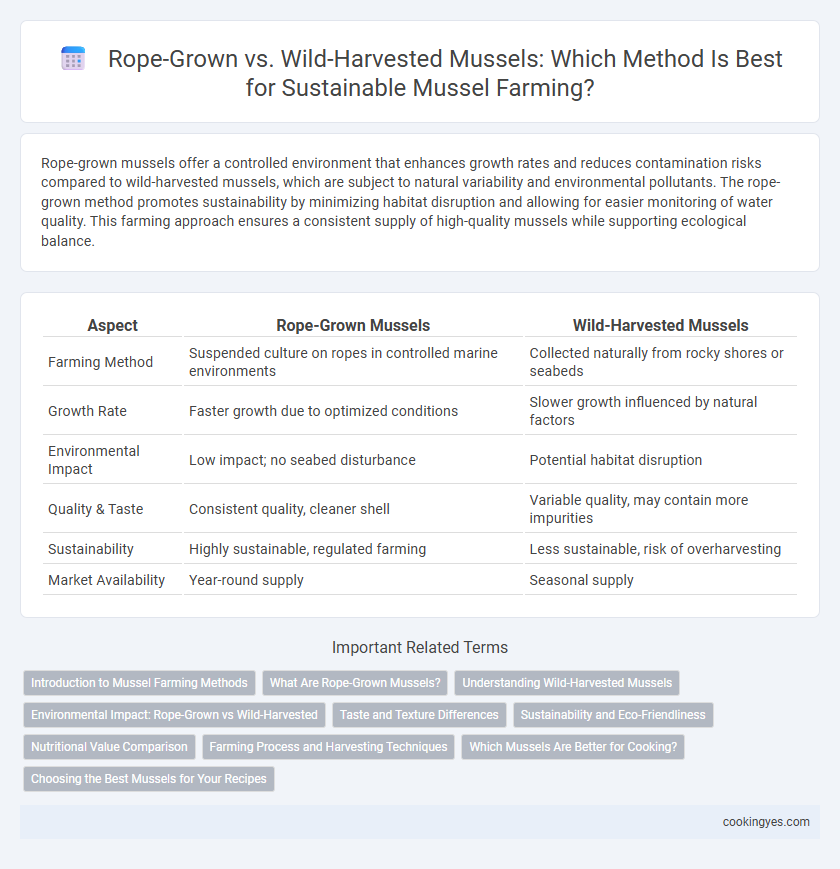Rope-grown mussels offer a controlled environment that enhances growth rates and reduces contamination risks compared to wild-harvested mussels, which are subject to natural variability and environmental pollutants. The rope-grown method promotes sustainability by minimizing habitat disruption and allowing for easier monitoring of water quality. This farming approach ensures a consistent supply of high-quality mussels while supporting ecological balance.
Table of Comparison
| Aspect | Rope-Grown Mussels | Wild-Harvested Mussels |
|---|---|---|
| Farming Method | Suspended culture on ropes in controlled marine environments | Collected naturally from rocky shores or seabeds |
| Growth Rate | Faster growth due to optimized conditions | Slower growth influenced by natural factors |
| Environmental Impact | Low impact; no seabed disturbance | Potential habitat disruption |
| Quality & Taste | Consistent quality, cleaner shell | Variable quality, may contain more impurities |
| Sustainability | Highly sustainable, regulated farming | Less sustainable, risk of overharvesting |
| Market Availability | Year-round supply | Seasonal supply |
Introduction to Mussel Farming Methods
Rope-grown mussels are cultivated on suspended ropes in coastal waters, allowing optimal growth conditions and reducing seabed disturbance compared to wild-harvested mussels. Wild-harvested mussels are collected directly from natural beds, which can impact local ecosystems and face variable yields due to environmental factors. Rope-grown methods offer controlled environments that enhance sustainability and consistent production in mussel farming.
What Are Rope-Grown Mussels?
Rope-grown mussels are cultivated by suspending young mussels on ropes in coastal waters, allowing them to filter feed naturally while minimizing sediment contamination. This aquaculture method ensures cleaner, more uniform mussels with higher growth rates compared to wild-harvested mussels collected directly from seabeds. Rope-grown mussels also benefit from controlled environmental conditions, reducing the risk of pollutants and improving overall quality and sustainability in mussel farming.
Understanding Wild-Harvested Mussels
Wild-harvested mussels are collected directly from their natural habitats, such as rocky shorelines and intertidal zones, where they grow attached to substrates in the wild. This method relies on natural growth cycles and environmental conditions, which can lead to variability in size, flavor, and nutrient content compared to rope-grown mussels. Understanding wild-harvested mussels involves recognizing their ecological impact, potential exposure to pollutants, and the importance of sustainable harvesting practices to maintain healthy mussel populations.
Environmental Impact: Rope-Grown vs Wild-Harvested
Rope-grown mussels significantly reduce environmental impact by minimizing seabed disturbance and promoting better water filtration compared to wild-harvested mussels, which can disrupt benthic ecosystems and marine biodiversity. Rope-grown mussels also help maintain cleaner marine environments by filtering large volumes of water without causing habitat destruction. This sustainable farming method supports healthier ocean ecosystems and reduces the ecological footprint associated with mussel production.
Taste and Texture Differences
Rope-grown mussels typically have a cleaner, brinier flavor and a firmer, more consistent texture due to the controlled farming environment that promotes even growth and reduces sediment exposure. Wild-harvested mussels often exhibit a stronger, more variable taste influenced by their natural habitat and diet, with a slightly chewier texture resulting from diverse water conditions and substrate. Both methods yield high-quality mussels, but rope-grown varieties are favored for their uniformity and milder flavor profile.
Sustainability and Eco-Friendliness
Rope-grown mussels demonstrate higher sustainability and eco-friendliness compared to wild-harvested methods, as they minimize seabed disturbance and promote cleaner water through natural filtration. This aquaculture technique reduces habitat degradation and allows for controlled growth cycles, supporting marine biodiversity and reducing overfishing pressures on wild populations. Sustainable rope-grown mussel farming contributes to healthier coastal ecosystems while providing a renewable seafood source with lower environmental footprints.
Nutritional Value Comparison
Rope-grown mussels typically exhibit higher concentrations of essential minerals such as zinc, iron, and omega-3 fatty acids compared to wild-harvested counterparts due to controlled feeding environments. Wild-harvested mussels may present greater variability in nutrient profiles influenced by their natural habitats and seasonal changes. Both methods yield mussels rich in protein and low in fat, but rope-grown mussels often demonstrate more consistent nutritional quality.
Farming Process and Harvesting Techniques
Rope-grown mussels are cultivated on suspended ropes, allowing for better water flow and reduced sediment accumulation, which enhances growth rates and shell quality. Wild-harvested mussels are collected directly from natural beds, requiring careful manual or mechanical techniques to minimize habitat damage and ensure sustainable populations. Rope cultivation offers controlled farming processes with predictable harvesting schedules, while wild harvesting depends on seasonal availability and environmental conditions.
Which Mussels Are Better for Cooking?
Rope-grown mussels typically offer a cleaner, more consistent texture and flavor due to controlled farming environments, making them ideal for culinary uses where appearance and taste matter. Wild-harvested mussels may possess a stronger, brinier flavor and are often found with varied shell sizes and occasional grit, which can impact cooking ease and presentation. Chefs often prefer rope-grown mussels for recipes requiring uniformity and tenderness, while wild mussels are favored for dishes that benefit from a robust, natural ocean flavor.
Choosing the Best Mussels for Your Recipes
Rope-grown mussels offer consistent size and cleaner shells, making them ideal for presentation and quick cooking in recipes demanding uniformity. Wild-harvested mussels often have a stronger, brinier flavor due to their natural diet and environment, enhancing dishes that benefit from robust seafood tastes. Selecting between rope-grown and wild-harvested mussels depends on your recipe's texture and flavor requirements, with an emphasis on freshness and sustainable sourcing for optimal culinary results.
Rope-grown vs wild-harvested for mussel farming Infographic

 cookingyes.com
cookingyes.com